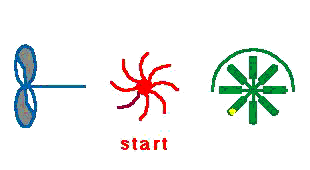 The three mechanical methods of measuring currents. The example assumes that the instruments are exposed to a current which flows from west to east, then pauses, then flows from east to west with the same strength as before, so that there is no net flow (the mean current is zero). It is also assumed that the orientation of the speed sensors is not changed in space during the experiment.
The three mechanical methods of measuring currents. The example assumes that the instruments are exposed to a current which flows from west to east, then pauses, then flows from east to west with the same strength as before, so that there is no net flow (the mean current is zero). It is also assumed that the orientation of the speed sensors is not changed in space during the experiment.The propeller rotor (left) turns as the current flows from west to east, stops, and turns backward as the current flows from east to west. But the backward turns do not cancel the forward turns because the propeller response to flow from its back is different to its response to flow coming from the front (a result of flow obstruction from the axle and instrument housing located behind the axle). Unless the propeller is specifically designed to have a cosine response to the flow, a propeller current meter thus only gives a reliable reading if the propeller always points into the current and its orientation is recorded along with the measured current speed.
The Savonius rotor (centre) turns anti-clockwise, stops, and continues to turn anticlockwise, effectively integrating over the current speed. It therefore gives a large apparent current speed. It does this independently of its orientation in space. A Savonius rotor thus gives a reliable reading only in situations where there is no high frequency alternating flow (such as produced, for example, close to the ocean surface by wind waves). Its reading has to be supplemented by independent information on current direction.
The paddle-wheel rotor (right) does not rotate at all unless one side of it is sheltered from the current. If it is sheltered, the paddle-wheel turns anti-clockwise first, then stops, then turns clockwise, and the clockwise rotation cancels the anti-clockwise rotation exactly. A paddle-wheel rotor thus produces a reliable reading. Its reading has to be supplemented by independent information on current direction.
contact address: